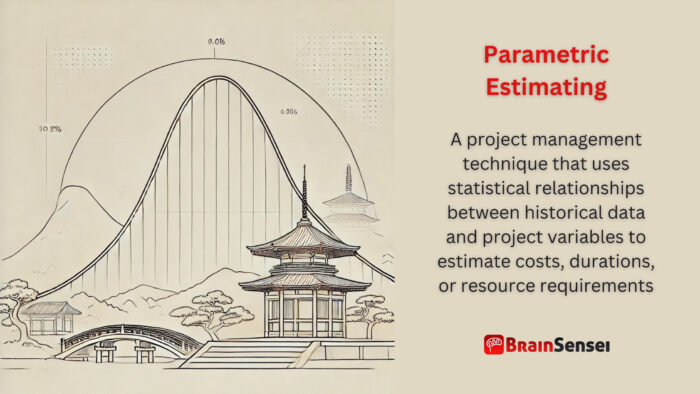
Parametric Estimating
What is Parametric Estimating?
Parametric estimating is a project management technique that uses statistical relationships between historical data and project variables to estimate costs, durations, or resource requirements. Project managers can produce more accurate and consistent estimates by applying mathematical models to quantify project elements.
Key Takeaways
- Utilizes historical data and mathematical models to generate estimates
- Improves accuracy through data-driven relationships between project variables
- Applicable to various project components like costs, timelines, and resource requirements
- More reliable than analogous estimating when sufficient data is available
- Requires ongoing updates to maintain accuracy as project conditions change
Understanding Parametric Estimating
How It Works
Parametric estimating involves identifying measurable factors (parameters) that influence a project and applying statistical methods to forecast outcomes. For instance, in construction projects, the cost per square meter of materials can be a parameter for estimating total material costs.
Steps typically include:
- Define Parameters: Project managers are crucial in identifying the cost or time factors influencing the project. Their understanding of the project’s scope and objectives is essential for this step.
- Collect Historical Data: Analyze past project data to find relationships.
- Develop a Model: Create mathematical models linking parameters to project elements.
- Apply Model: Use the model to estimate current project requirements.
- Refine Estimates: Update the model with real-time data for greater accuracy.
Notes
- Requires reliable, relevant, and comprehensive historical data
- Inaccurate or outdated data can lead to significant errors
- Regularly recalibrate models to account for changing project conditions
- Best suited for repetitive tasks with consistent variables
- Complex models may need expert statistical analysis
Related Terms
- Analogous Estimating: Uses expert judgment and historical data from similar projects to estimate costs or durations.
- Bottom-Up Estimating: Involves breaking down a project into smaller tasks and estimating each individually.
- Cost Estimation: Predicting project costs based on defined assumptions and variables.
- Quantitative Risk Analysis: Uses numerical techniques to assess potential project risks.
- Resource Allocation: Assigns available resources to tasks based on project requirements.
Examples of Parametric Estimating
Construction Industry
A construction company is planning a new office building. The average cost per square meter is $2,000 based on past projects. For a 5,000-square-meter building:
- Cost Estimate = 5,000 * $2,000 = $10,000,000. Using parametric estimating, the company efficiently forecasts project costs and identifies potential savings through material cost analysis.
To break this down further, the project manager analyzes different components such as materials, labour, and equipment. Historical data indicates that materials constitute 60% of the total cost, labour 30%, and equipment 10%. Therefore:
- Materials: $6,000,000
- Labor: $3,000,000
- Equipment: $1,000,000
With this detailed breakdown, the project team can identify potential cost-saving opportunities, such as negotiating bulk material discounts or optimizing labour allocation. The model also continuously incorporates external factors like inflation and market trends to refine estimates.
IT and Software Development
A software firm uses historical data showing that developing one software module requires approximately 120 hours. For a new project with 10 modules:
- Time Estimate = 10 * 120 = 1,200 hours. Parametric estimating helps allocate developer resources and project timelines accurately.
Expanding on this, the development team segments tasks into design, coding, testing, and deployment. Historical records suggest the following distribution:
- Design: 20% (240 hours)
- Coding: 50% (600 hours)
- Testing: 20% (240 hours)
- Deployment: 10% (120 hours)
By applying parametric estimating, the firm anticipates bottlenecks and allocates resources accordingly. For example, if historical data shows prolonged testing phases in similar projects, the firm may assign more testers. The model also factors in variations like the modules’ complexity or the developers’ experience level.
Aerospace Industry
An aerospace manufacturer uses historical data indicating that each aircraft requires 300 engineering hours per engine. For a project involving 20 engines:
- Time Estimate = 20 * 300 = 6,000 hours. The technique ensures resource availability and budgeting accuracy.
The manufacturer thoroughly examines the engineering hours across design, assembly, and testing. Historical data provides the following insights:
- Design: 40% (2,400 hours)
- Assembly: 35% (2,100 hours)
- Testing: 25% (1,500 hours)
The parametric model also integrates engine complexity, workforce productivity, and technological advancements. The manufacturer can continuously update these parameters to forecast labour costs, schedule milestones, and identify performance trends to improve future estimates.
These three examples illustrate how parametric estimating can be applied across diverse industries to generate precise forecasts, optimize resources, and improve project predictability. Other industries where parametric estimating can be beneficial include healthcare, where it can predict patient wait times; retail, where it can forecast sales based on historical data; and education, where it can estimate student enrollment numbers.
Use Cases of Parametric Estimating
United States (Infrastructure Development)
In a large-scale infrastructure project, parametric estimating helped forecast the costs of road construction using data on materials and labour costs from similar projects. The estimation method enabled efficient budgeting and minimized resource waste. The project involved building a new highway spanning several states. It required precise estimates for asphalt, labour, equipment, and contingency costs. By analyzing historical data from previous road projects, the team identified patterns in cost fluctuations due to seasonal weather conditions and labour availability. Through parametric modelling, they accurately forecast costs and timelines, which allowed for better contract negotiations and resource planning.
Parametric estimating also facilitated real-time adjustments when unexpected factors, like supplier delays, emerged. Historical patterns showed that similar disruptions typically extended project duration by 10-15%. By applying this insight, project managers could communicate realistic updates to stakeholders, manage expectations, and avoid costly last-minute changes.
Europe (Renewable Energy Projects)
A wind energy company applied parametric estimating to predict turbine installation times based on past performance. This technique facilitated better resource allocation and on-time project delivery. The company analyzed data from multiple wind farm projects, focusing on variables like turbine size, installation crew experience, and site accessibility. Parametric models indicated larger turbines required more installation hours, especially in remote locations.
During execution, the company discovered that transport logistics for turbine components varied significantly across sites. The parametric model, enriched with historical transportation data, helped project managers allocate resources strategically. For example, the team first scheduled sites with limited road access to avoid congestion during peak construction periods. The company also tracked cost savings achieved through optimized crew assignments, demonstrating the practical benefits of parametric estimating.
Asia (Telecom Expansion)
A telecommunications provider used parametric estimating to estimate costs for installing new cellular towers. The process relied on historical labour, equipment, and materials data, ensuring realistic budget forecasts. The project expanded network coverage across urban and rural areas, each with unique logistical challenges.
Reviewing past tower installations, project managers identified key cost drivers such as tower height, terrain complexity, and crew travel expenses. Parametric models revealed that installations in mountainous regions consistently exceeded costs due to specialized equipment needs and prolonged setup times. Using these insights, the company adjusted budgets and implemented proactive measures, like partnering with local contractors to reduce transportation costs.
The project’s success highlighted parametric estimating’s predictive power. The company met its budgetary goals while completing installations ahead of schedule, which underscored the importance of continuously updating models with new data to maintain accuracy across diverse operational environments.
Best Practices for Parametric Estimating
To maximize parametric estimating effectiveness:
Use High-Quality, Relevant Historical Data
Historical data forms the foundation of parametric estimating. Ensure the data is accurate, complete, and relevant to the current project’s scope. For instance, using outdated labour cost rates or material prices can distort estimates, leading to budget overruns.
Validate Models with Real-World Results
Parametric models should not rely solely on historical data. The project team should regularly validate the models by comparing estimated figures against actual project outcomes. Discrepancies should trigger a review of the model’s assumptions and parameters.
Regularly Update Models
Project environments evolve, changing cost structures, productivity rates, and technological efficiencies. Regular updates ensure the model remains reflective of current industry conditions. For example, construction costs may rise due to market demand, requiring model recalibration.
Integrate with Other Estimating Methods
While parametric estimating offers precision, combining it with analogous or bottom-up estimating can provide a more comprehensive view. Hybrid approaches minimize estimation errors for complex projects.
Invest in Team Training
Equip team members with the skills to interpret, apply, and adjust parametric models. Understanding the statistical basis of these models helps project managers identify anomalies and make informed decisions.
Use Technology Wisely
Utilize modern project management tools that support parametric estimating. Software like Primavera P6 and Microsoft Project provide robust functionalities for data analysis, model creation, and real-time updates.
Communicate Findings Clearly
The project team must communicate to stakeholders the estimates derived from parametric models. Presenting complex data in simplified formats, such as charts or dashboards, enhances decision-making and fosters trust in the methodology.
Following these best practices helps project managers achieve more accurate, reliable estimates, improving project planning, budgeting, and execution.
Common Mistakes and Issues
Parametric estimating, while effective, can encounter several challenges and mistakes if not adequately managed. Below are key pitfalls and their implications:
Inaccurate or Incomplete Historical Data
Historical data is the cornerstone of parametric estimating. Using incomplete, outdated, or irrelevant data can produce grossly inaccurate estimates. For example, a construction firm once used decade-old material costs, resulting in a 20% budget overrun.
Misidentifying Key Parameters
Selecting the wrong variables or overlooking critical factors can compromise the model’s accuracy. In software development, disregarding team experience levels might cause discrepancies in time estimates.
Overreliance on Models
While parametric models provide reliable estimates, blind dependence on these tools without contextual judgment can be problematic. For example, an inaccurate model delayed a telecom project because it underestimated the time required for installations in mountainous regions.
Lack of Model Calibration
Failing to update models with recent data diminishes their relevance. Regular calibration ensures estimates reflect current market trends, labour rates, and technological advancements.
Inadequate Team Training
If team members don’t fully grasp how to interpret and apply models, the risk of errors increases. Continuous training and documentation mitigate this issue.
Addressing these challenges, project managers can harness the full potential of parametric estimating to plan projects more reliably and accurately.
Frequently Asked Questions (FAQs)
How is parametric estimating different from analogous estimating?
Parametric estimating relies on statistical relationships and historical data, while analogous estimating uses expert judgment and comparisons with similar past projects.
When should parametric estimating be used?
It’s most effective when sufficient historical data and project parameters are clearly defined.
What tools are commonly used for parametric estimating?
Project management software like Primavera P6, Microsoft Project, and proprietary parametric models.
What industries benefit most from parametric estimating?
Parametric estimating benefits industries with repetitive, data-rich processes like construction, aerospace, IT, and manufacturing.
What are the main challenges of parametric estimating?
Ensuring data accuracy, model validation, and adapting models to project-specific contexts.
Additional Resources
- Parametric Cost Modeling for Buildings
- Project Estimation: 9 Points to Set the Schedule
- Cost Estimation
Preparing for a PMI certification?
- Exam Prep Courses: PMP®, CAPM®, and PMI-ACP®
- Exam Simulators: PMP®, CAPM®, PMI-ACP®, PMI-PBA®, PMI-RMP®, PMI-SP®, PgMP®, and PfMP®
- Professional Development Units (PDUs): 15, 30, and 60 PDU Bundles



